Think your finger picking technique is terrible? That sucks! Fix it now with this guide.
Is your fingerstyle getting out of hand? Unfortunately, you may have started out playing fingerstyle guitar without much consideration for proper technique, especially for that plucking action.
So in this guide, I'm going to give you the easy steps to achieve the perfect technique for fingerpicking on guitar.
You see, when it comes to proper fingerstyle guitar technique, it all comes down to avoiding one mistake. When you realize this mistake, your finger picking sound quality and technique will drastically improve.
Let's get into improving your fingerstyle technique so you can start finger picking like a pro.
- What Is Proper Finger Picking Technique?
- How To Pluck The Strings When Finger Picking
- Where Do You Rest Your Plucking Hand When Fingerpicking?
- What Is the Difference Between Rest Stroke and Free Stroke?
- What Is The Proper Fingerpicking Hand Position?
- What Is The Proper Technique For The Plucking Fingers?
- Should I Use Finger Picks When Playing Fingerstyle Guitar?
What Is Proper Finger Picking Technique?
Proper finger picking technique is actually pretty straightforward to evaluate: if you are able to create a nice loud sound on the guitar using a pick, but then notice a considerable drop in sound when finger picking, you are likely using improper technique.
So, we need to apply the same principles that go into creating a nice fat sound with the pick into making a louder fingerstyle sound.
For proper fingerstyle guitar technique, ensure that your wrist is flat or slightly bent while playing fingerstyle guitar. This helps avoid rest stroke and promotes efficient finger movement.
We'll talk more about rest stroke in a later section. For now, let's learn the proper way to pluck the strings, which is using free stroke.
How To Pluck The Strings When Finger Picking
My first guitar was adamant that to perform correct plucking technique, you needed to understand that the movement of the finger originates from the knuckle.
However, if this doesn't work for you, I have an alternate description that makes you ultimately do the same movement.
Focus on making the fingertip swing towards the palm of your hand while plucking. Avoid using the middle joint of the finger when you pluck and don't use a huge finger movement.
Proper Plucking Finger Motion
When plucking the string, the tip of the finger should set the string in motion. Avoid pulling the string away from the guitar as this creates a twanging sound. Also avoid exaggerating the finger movement as this can hinder speed later on.
You can also grow your right hand fingernails to improve the contact of the finger with the string, or the tone of the guitar when you pluck it.
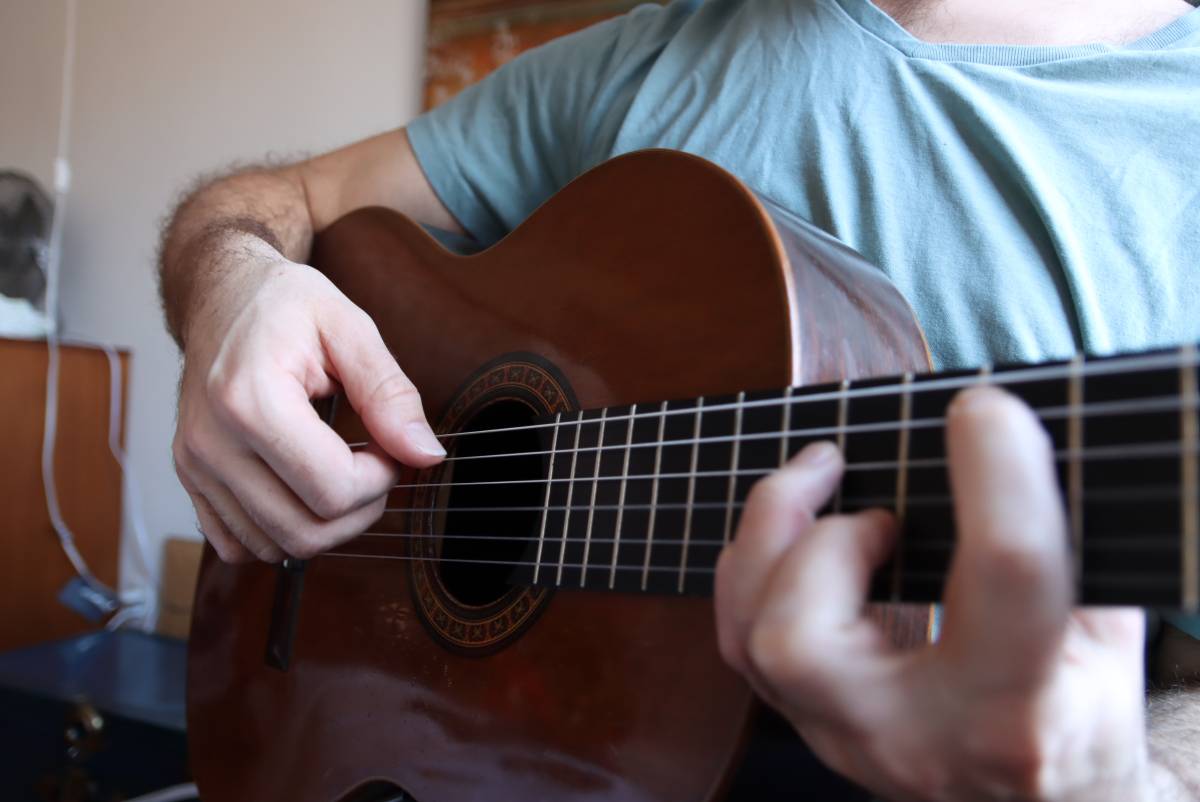
If you notice fatigue and sluggish performance, you may be making this one mistake: using the same finger repeatedly on the same string. To fix this, practice alternate picking when playing fingerstyle guitar by working on scales or simple melodies.
Also, there should be no buzzing. Your fretting hand fingers should land as close as possible to the frets. You should be aware of how your wrist is bent and how your thumb is positioned behind the neck.
Where Do You Rest Your Plucking Hand When Fingerpicking?
Here's the difference between self-taught guitarists and those who have done formal training: Guitarists who took lessons know that you should not rest the palm of your hand against anything when fingerpicking.
However, self-taught guitarists will place the pinky finger of their plucking hand right against the sound hole, using it as an "anchor" to keep the hand steady.
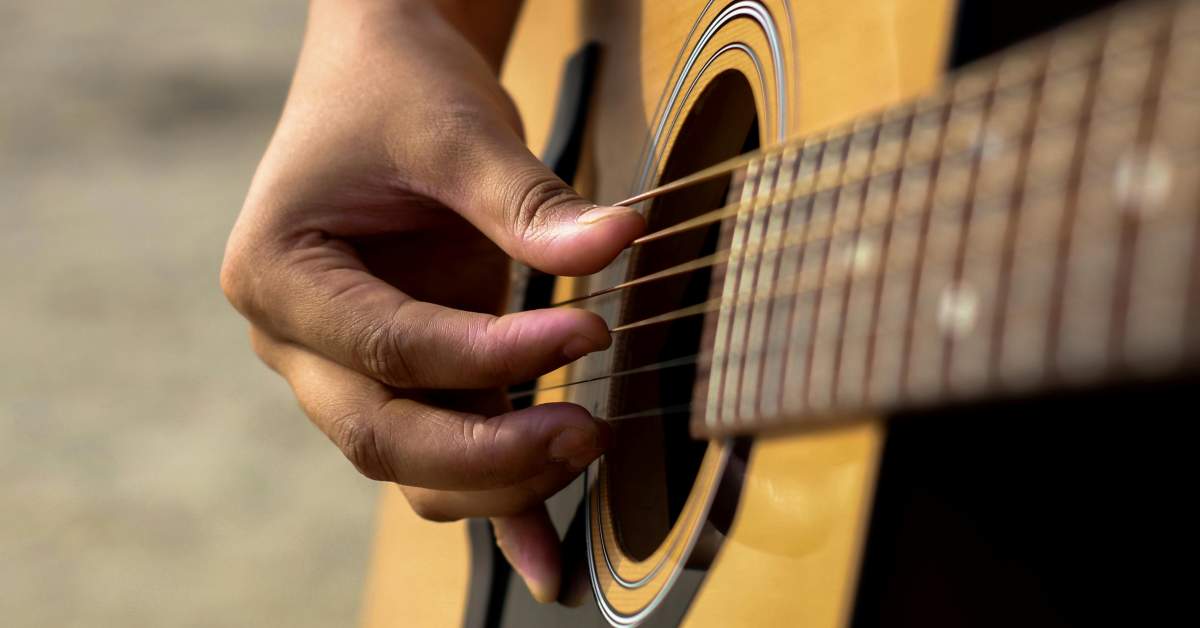
So, who's correct? After seeing some excellent guitarists position their hand this way, I can't say one way is right or wrong.
What Is the Difference Between Rest Stroke and Free Stroke?
Rest stroke involves plucking a string and having the fingertip rest against an adjacent string after plucking. Electric bass players and flamenco guitarists use rest stroke to play fast single note soloing.
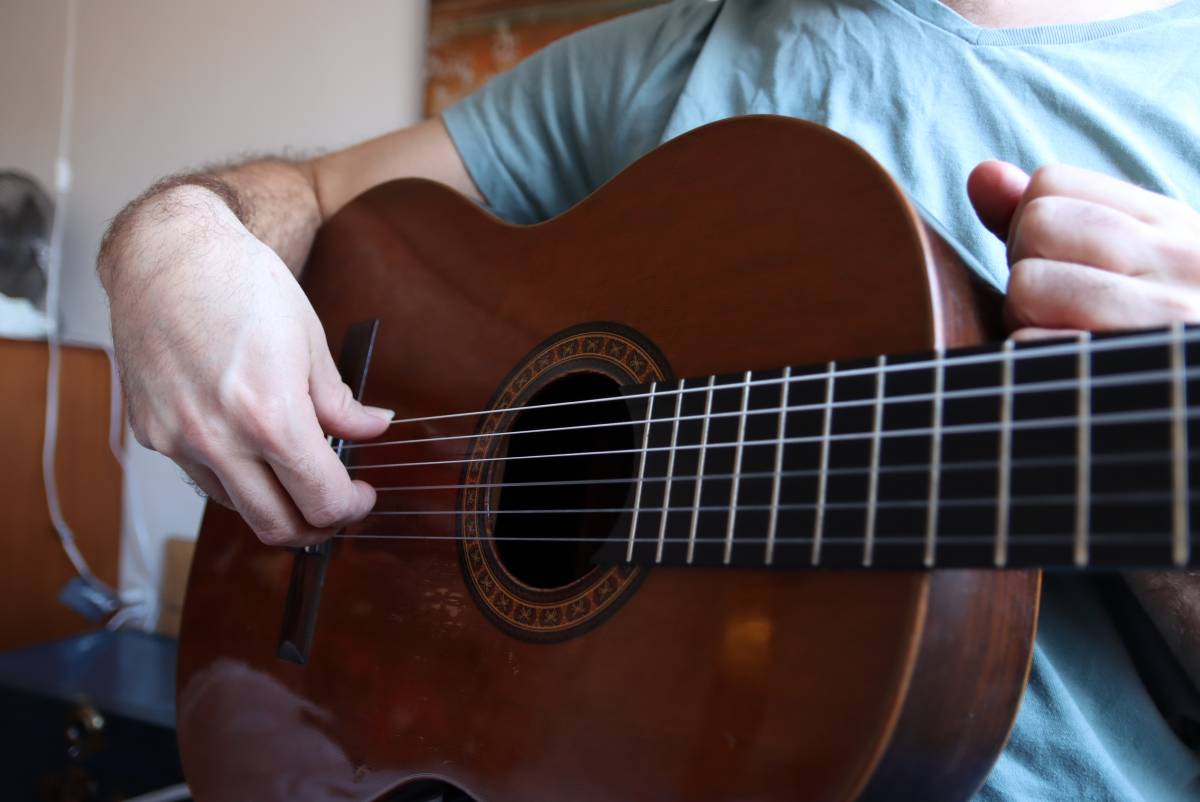
With rest stroke, the plucking finger completes the movement by resting against the adjacent string.
It's impossible to perform rest stroke with the fingers on the sixth string if you have a six-string guitar. However you can perform rest stroke using the thumb, and in flamenco guitar this technique produces a sweeping motion across the bass strings, called alzapua.
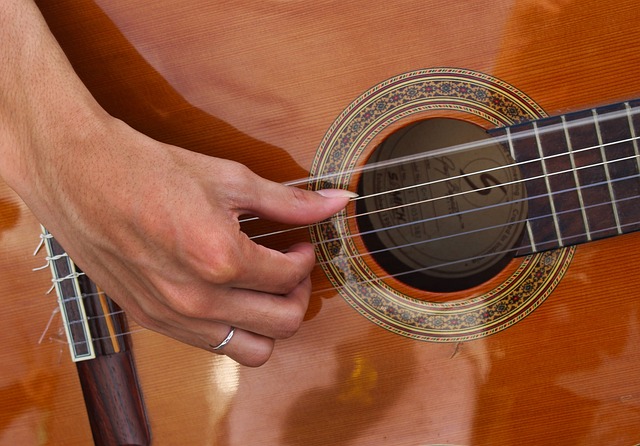
We want to avoid rest stroke when playing fingerstyle guitar songs. Rest stroke technique limits what we can perform in terms of arpeggios and chords with fingerstyle guitar.
Instead, we will only use free stroke. With free stroke, the fingertip moves underneath the hand and never comes in contact with the string.
What Is The Proper Fingerpicking Hand Position?
If you find that you are pulling the string or the plucking hand away from the guitar, your finger is likely not plucking the string at the correct angle. You may be moving the hand laterally towards the fretboard or towards the bridge
You can fix this by adjusting your hand position to allow the entire finger to pluck the string, instead of just the middle joint. Bend the wrist slightly and allow the middle joint of your finger to move towards your hand, instead of away from the instrument.
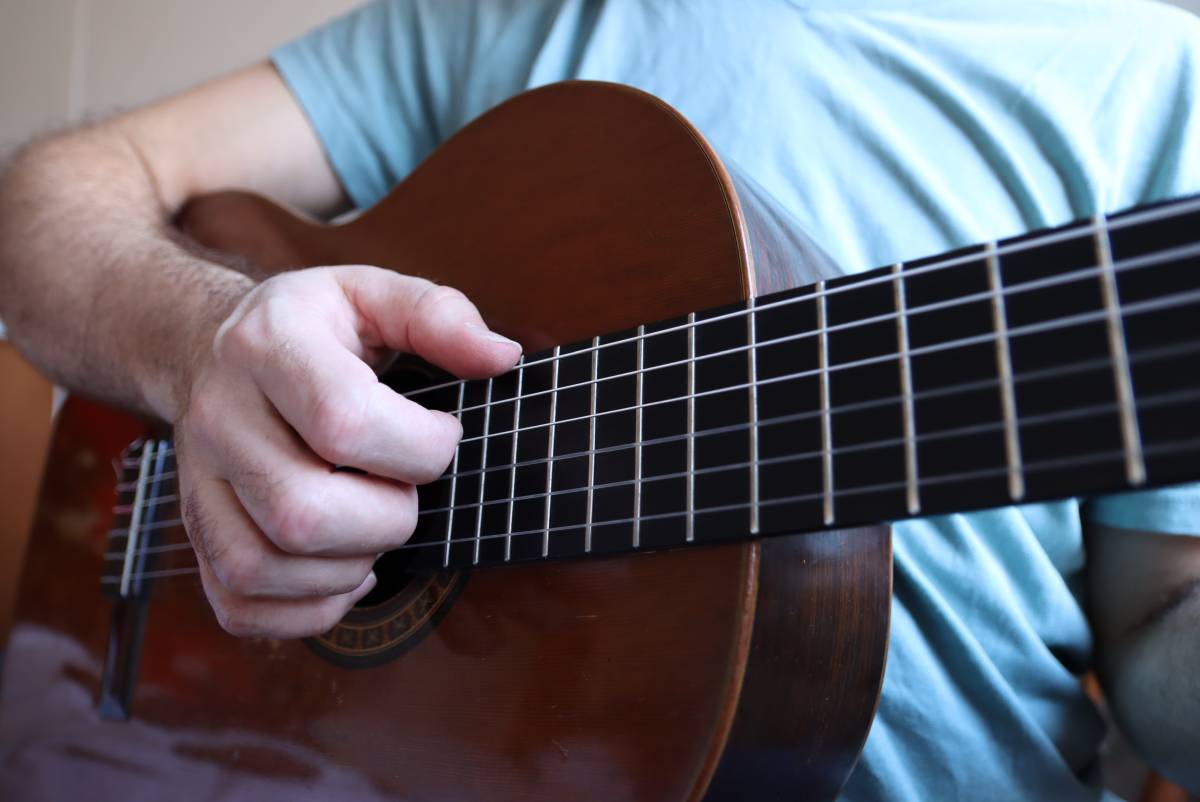
Also, your hand should stay suspended above the strings in a neutral position when finger picking. If your right hand exits the guitar as you play, you will be constantly resetting your fretting hand position. You generally don't need to look at your plucking hand, because your fretting hand can move a much larger distance. Your plucking hand should stay over the same area.
If you are landing on the wrong strings when playing fingerstyle guitar, check that your hand maintains the correct placement at all times. You must be able to play songs by mostly concentrating on what the left hand does. You can practice arpeggios to improve your right hand independence.
Wrist Position for Fingerstyle Guitar
When playing fingerstyle guitar, make sure the wrist of the plucking hand isn't too flat. By lifting the wrist slightly away from the guitar, you will allow your fingertip to move underneath the palm of your hand. This will give you better tone quality and agility.
Another common fingerstyle guitar mistake is looking at both hands.
The plucking hand should be independent from the fretting hand.
What Is The Proper Technique For The Plucking Fingers?
Imagine that instead of walking down the street normally, you had to hop only using one leg. Your gait would be less smooth and bouncy.
It's the same thing with fingerstyle guitar: if you are playing a series of notes on one string, avoid using the same finger in secession.
Alternate finger picking in fingerstyle guitar involves using different fingers for a succession of notes on the same string.
How To Practice Alternating Fingers
You'll want to avoid repetitive “PIPIPIPI” traps (overusing the thumb and index finger in a predictable pattern). Practice alternating between your index and your middle fingers as you play a passage on one string. You can play a scale or a melody; just don't add anything with the thumb.
Once you get comfortable with alternating your index and middle fingers (something called "walking fingers"), next practice alternating between a bass string with the thumb and the index or the middle finger on one of the higher strings.
You can practice this motion in a song called the "Alternating Bass Blues" which is featured in the online course Play Fingerstyle Guitar Now!
Can I Play Fingerstyle Guitar With Only Two Fingers?
Although you can correctly use two different fingers to perform alternate finger picking, I recommend learning to play fingerstyle guitar with the thumb and the three fingers of the right hand.
Pluck the first note with your index finger, the second note with your middle finger, and the third note with your index.
So on and so forth.
Another problem with only two fingers is that it requires you to sweep the finger across the strings, like sweep picking, when you are doing an arpeggio. Steer clear of sweeping fingers across strings, and use arpeggio picking patterns instead.
To transform your fingerpicking from using only two fingers to using three or four fingers, practice a scale in finger picking. The best way to practice proper plucking hand exercises is with the songs that you will find in the complete online course for learning to play fingerstyle guitar, called Play Fingerstyle Guitar Now!
Strumming In Fingerstyle Guitar
Some fingerstyle guitar songs such as those by Sungha Jung contain passages where you have to strum fairly quick rhythmic patterns.
Strumming in fingerstyle guitar often uses the rasgueado technique. This is a method of strumming borrowed from flamenco guitar that involves using the fingernails to strike the strings, instead of a pick.
Should I Use Finger Picks When Playing Fingerstyle Guitar?
I recommend playing fingerstyle guitar with fingernails (real or artificial) or simply playing without nails, in order to feel the contact of the string with the fingertip of the plucking hand.
However, if you are unhappy with the tone that your fingertips produce, there are special finger picks that you can use to play fingerstyle guitar.
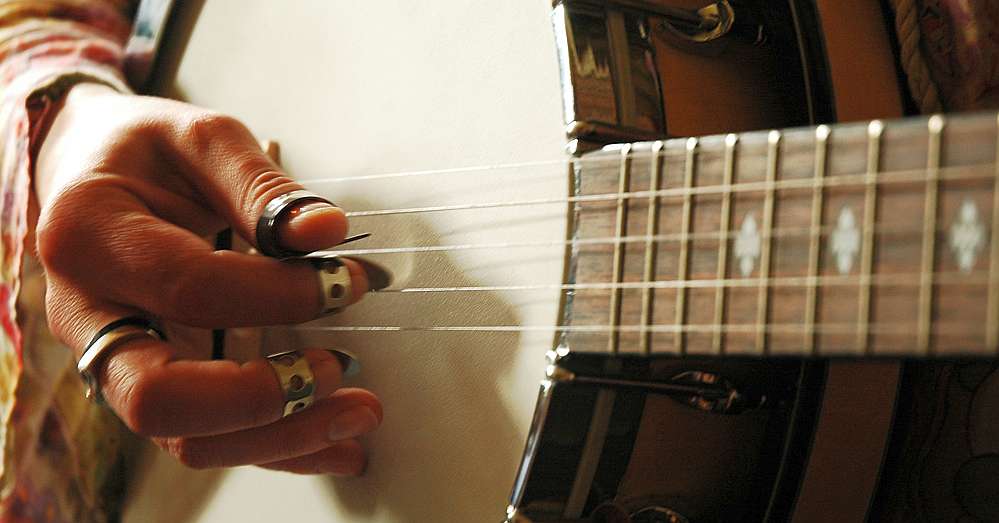
Some fingerpicks are made entirely of metal and cover the fingertip entirely. Other finger picks, such as Alaska picks, slip between the fingernail and the fingertip.
I have never had much success playing fingerstyle guitar with finger picks, which is why I don't recommend them.



